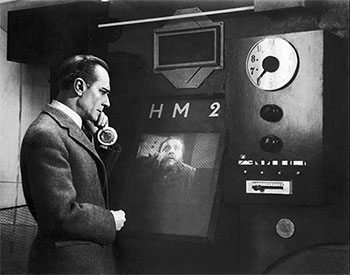The popular cartoon “The Jetsons” provided baby boomers a glimpse of what great things the future held — from robot maids to flying cars. Rather than making simple phone calls, the characters were often seen using real-time video streaming, whether it be Jane talking with her family or George getting a call from his boss, Mr. Spacely, yelling, “JETSON!!!”
In 2015 we have far surpassed the expectations of the Jetsons, with real-time video streaming technology being used regularly in business and home environments such as IPTV Service or Satellite, Cable, etc.. And what’s more, its use isn’t confined to a single monitor, but can be used on-the-go from a variety of mobile devices.
While real-time video streaming is no longer something to be imagined, there are still industries that have yet to fully embrace its infinite uses. Here’s our own futuristic look at industries that will start realizing the benefits of real-time video streaming in 2015 and beyond.
Law Enforcement
 Increasingly, law enforcement agencies are realizing the benefits of equipping their officers with body-worn video cameras. The use of body cameras reduces tension between the police and the public they serve, and provides a record of an encounter between an officer and a civilian to prevent frivolous accusations. However, viewing video evidence after an incident is no longer enough.
Increasingly, law enforcement agencies are realizing the benefits of equipping their officers with body-worn video cameras. The use of body cameras reduces tension between the police and the public they serve, and provides a record of an encounter between an officer and a civilian to prevent frivolous accusations. However, viewing video evidence after an incident is no longer enough.
Police departments will eventually be required to equip their officers with body-worn cameras that will live stream footage back to the command center, and house captured footage off the device for safekeeping. This will enable real-time assistance, which may prevent unnecessary incidents from occurring altogether, and will ensure evidence isn’t lost or tampered with.
Oil and Gas
 As the lifeblood of the global economy, it’s crucial that the oil and gas industry operates as efficiently as possible. However, issues typically occur in remote locations—far from company headquarters—which can slow down important inspections, equipment maintenance and infrastructure troubleshooting that ensure operations continue as usual.
As the lifeblood of the global economy, it’s crucial that the oil and gas industry operates as efficiently as possible. However, issues typically occur in remote locations—far from company headquarters—which can slow down important inspections, equipment maintenance and infrastructure troubleshooting that ensure operations continue as usual.
Real-time video streaming will fuel remote collaboration in oil and gas by helping to easily connect workers at these remote locations with subject matter experts back at headquarters—speeding up problem resolution and improve production uptime.
Automotive
 The auto industry is facing a shortage of skilled technical manpower at a time when rapid advances in vehicle technology are requiring auto workers to go far beyond just fixing starters, spark plugs, pistons and carburetors. This means that mechanics are likely to face more complex technical repairs, such as computer troubleshooting, and their ability to accurately describe the issue can make the difference between getting the vehicle back on the road… or not.
The auto industry is facing a shortage of skilled technical manpower at a time when rapid advances in vehicle technology are requiring auto workers to go far beyond just fixing starters, spark plugs, pistons and carburetors. This means that mechanics are likely to face more complex technical repairs, such as computer troubleshooting, and their ability to accurately describe the issue can make the difference between getting the vehicle back on the road… or not.
To help resolve issues quickly, the auto industry will begin equipping mechanics with real-time video streaming technology so they can immediately connect with subject matter experts who can “see” the problems the mechanics are dealing with and give instantaneous guidance on how to resolve them.
Cable
 Cable, telephone and Internet are now combined into a single solution that is part of a much bigger entertainment ecosystem. When today’s cable technician arrives at the customer’s home for a service call, he is troubleshooting a complex system that includes (but isn’t limited to) routers, STBs, Wi-Fi, VoIP, Smart TVs and DVRs. Even though the cable tech is a multi-domain expert, he may encounter something outside of his realm of expertise.
Cable, telephone and Internet are now combined into a single solution that is part of a much bigger entertainment ecosystem. When today’s cable technician arrives at the customer’s home for a service call, he is troubleshooting a complex system that includes (but isn’t limited to) routers, STBs, Wi-Fi, VoIP, Smart TVs and DVRs. Even though the cable tech is a multi-domain expert, he may encounter something outside of his realm of expertise.
The cable industry will start equipping field techs with real-time video streaming software so that they can instantly broadcast any issues or irregularities to support teams at headquarters. This will be much more effective than describing what the cable tech is seeing over the phone, and will ensure that the issue is resolved in a timely manner. The technician will be able to get to his next appointment on time, and the customer will be back up and running as quickly as possible.
A Final Word
The uses of real-time video streaming are infinite, and we’re only scratching the surface when it comes to the benefits it will present. While there are already forward-looking companies that have begun using real-time video streaming in law enforcement, oil and gas, automotive, and cable, we will eventually see its use as prevalent as videoconferencing in the boardroom.
Are you in one of these industries taking advantage of real-time video streaming? We’d love to hear how you’re using it and what you think!

 Often, these first-time visits end up being classified as “cockpit error” — a simple solution that could have been fixed with proper troubleshooting by customer care agents if they had a clear view of the problem. For instance, they might see that someone unplugged a cable and plugged it into the wrong connection. However, with today’s complex systems, having customers try to describe the problem over a phone call becomes increasingly more complicated. Thus, the support phone call turns into scheduling an on-site visit.
Often, these first-time visits end up being classified as “cockpit error” — a simple solution that could have been fixed with proper troubleshooting by customer care agents if they had a clear view of the problem. For instance, they might see that someone unplugged a cable and plugged it into the wrong connection. However, with today’s complex systems, having customers try to describe the problem over a phone call becomes increasingly more complicated. Thus, the support phone call turns into scheduling an on-site visit. As the storm settled in Massachusetts, like much of the East Coast, witnessed fierce winds creating white-out conditions. Along the coastline south of Boston, the National Guard evacuated residents in the town of Marshfield, a 100 ft. section of seawall was breached by a storm surge that caused extreme flooding in the surrounding area. And the snow? Buffalo, New York, experienced record-breaking snowfall that blanketed much of the city and forced residents and businesses alike to dig themselves out. Streets were empty, and drivers faced zero visibility on the highways.
As the storm settled in Massachusetts, like much of the East Coast, witnessed fierce winds creating white-out conditions. Along the coastline south of Boston, the National Guard evacuated residents in the town of Marshfield, a 100 ft. section of seawall was breached by a storm surge that caused extreme flooding in the surrounding area. And the snow? Buffalo, New York, experienced record-breaking snowfall that blanketed much of the city and forced residents and businesses alike to dig themselves out. Streets were empty, and drivers faced zero visibility on the highways. Increasingly, law enforcement agencies are realizing the benefits of equipping their officers with body-worn video cameras. The use of body cameras reduces tension between the police and the public they serve, and provides a record of an encounter between an officer and a civilian to prevent frivolous accusations. However, viewing video evidence after an incident is no longer enough.
Increasingly, law enforcement agencies are realizing the benefits of equipping their officers with body-worn video cameras. The use of body cameras reduces tension between the police and the public they serve, and provides a record of an encounter between an officer and a civilian to prevent frivolous accusations. However, viewing video evidence after an incident is no longer enough. As the lifeblood of the global economy, it’s crucial that the oil and gas industry operates as efficiently as possible. However, issues typically occur in remote locations—far from company headquarters—which can slow down important inspections, equipment maintenance and infrastructure troubleshooting that ensure operations continue as usual.
As the lifeblood of the global economy, it’s crucial that the oil and gas industry operates as efficiently as possible. However, issues typically occur in remote locations—far from company headquarters—which can slow down important inspections, equipment maintenance and infrastructure troubleshooting that ensure operations continue as usual. The auto industry is facing a shortage of skilled technical manpower at a time when rapid advances in vehicle technology are requiring auto workers to go far beyond just fixing starters, spark plugs, pistons and carburetors. This means that mechanics are likely to face more complex technical repairs, such as computer troubleshooting, and their ability to accurately describe the issue can make the difference between getting the vehicle back on the road… or not.
The auto industry is facing a shortage of skilled technical manpower at a time when rapid advances in vehicle technology are requiring auto workers to go far beyond just fixing starters, spark plugs, pistons and carburetors. This means that mechanics are likely to face more complex technical repairs, such as computer troubleshooting, and their ability to accurately describe the issue can make the difference between getting the vehicle back on the road… or not. Cable, telephone and Internet are now combined into a single solution that is part of a much bigger entertainment ecosystem. When today’s cable technician arrives at the customer’s home for a service call, he is troubleshooting a complex system that includes (but isn’t limited to) routers, STBs, Wi-Fi, VoIP, Smart TVs and DVRs. Even though the cable tech is a multi-domain expert, he may encounter something outside of his realm of expertise.
Cable, telephone and Internet are now combined into a single solution that is part of a much bigger entertainment ecosystem. When today’s cable technician arrives at the customer’s home for a service call, he is troubleshooting a complex system that includes (but isn’t limited to) routers, STBs, Wi-Fi, VoIP, Smart TVs and DVRs. Even though the cable tech is a multi-domain expert, he may encounter something outside of his realm of expertise. It’s important to take a look, however, at what wasn’t visible to CES attendees marveling at these huge screens and incredible images. What they did not see was the dedicated, high-powered video server just behind the show walls bringing these unbelievable images to life. They also didn’t notice the network of cables that linked this server to the screen. But even if they did, why would they care? Everyone knows that today’s TVs require a hardwired cable or internet feed for top performance, and homes are built to accommodate this need. But video for business is a completely different ball game, with different goals and different rules. Streaming video is often used outside controlled environments, such as remote on-the-job locations with unreliable network coverage, where inevitable obstacles compromise video performance.
It’s important to take a look, however, at what wasn’t visible to CES attendees marveling at these huge screens and incredible images. What they did not see was the dedicated, high-powered video server just behind the show walls bringing these unbelievable images to life. They also didn’t notice the network of cables that linked this server to the screen. But even if they did, why would they care? Everyone knows that today’s TVs require a hardwired cable or internet feed for top performance, and homes are built to accommodate this need. But video for business is a completely different ball game, with different goals and different rules. Streaming video is often used outside controlled environments, such as remote on-the-job locations with unreliable network coverage, where inevitable obstacles compromise video performance. At its core, the term Information Fidelity refers to video viewed with the lowest possible latency and no buffering delays (which can pause the video for 5, 10, 15 seconds or more). Instead of having to wait for the video to play catch-up due to a poor network connection or interference, the viewer on the other end of the video will experience a seamless stream of video that provides the visual information required to get the job done.
At its core, the term Information Fidelity refers to video viewed with the lowest possible latency and no buffering delays (which can pause the video for 5, 10, 15 seconds or more). Instead of having to wait for the video to play catch-up due to a poor network connection or interference, the viewer on the other end of the video will experience a seamless stream of video that provides the visual information required to get the job done. Part of Albert’s job is overseeing a complex network of equipment on the production line. Each piece of equipment performs a unique function and, for the most part, sourced from different suppliers. The complexity and diversity of the machines can cause Albert quite the headache if something goes wrong and can lead to serious downtime and lost revenue.
Part of Albert’s job is overseeing a complex network of equipment on the production line. Each piece of equipment performs a unique function and, for the most part, sourced from different suppliers. The complexity and diversity of the machines can cause Albert quite the headache if something goes wrong and can lead to serious downtime and lost revenue. A discussion with S.T. Nicholas of Arctic Pole Industries
A discussion with S.T. Nicholas of Arctic Pole Industries
 For most companies, the job is done when the product is packed and shipped. Not so with Arctic Pole. “SANTA is all about ensuring delivery to the end user, and once again, Vidcie has proven to be indispensable” states Nicholas. “When we arrive on site, we must ensure that everything goes according to plan, with no surprises. While wind, snow and roof pitch are all occupational hazards, other pitfalls are easily avoided with Vidcie Live Video. A great example is the smokestack
For most companies, the job is done when the product is packed and shipped. Not so with Arctic Pole. “SANTA is all about ensuring delivery to the end user, and once again, Vidcie has proven to be indispensable” states Nicholas. “When we arrive on site, we must ensure that everything goes according to plan, with no surprises. While wind, snow and roof pitch are all occupational hazards, other pitfalls are easily avoided with Vidcie Live Video. A great example is the smokestack Real-time video technology has gained popularity at an impressive pace, with services like Skype and FaceTime making it easier than ever to stay in touch with friends, family and coworkers anywhere in the world. While these may be wonderful choices for consumers and even business users, let’s take a look at whether they adequately meet the needs of field service organizations where on-site problem-solvers need to connect with remote experts.
Real-time video technology has gained popularity at an impressive pace, with services like Skype and FaceTime making it easier than ever to stay in touch with friends, family and coworkers anywhere in the world. While these may be wonderful choices for consumers and even business users, let’s take a look at whether they adequately meet the needs of field service organizations where on-site problem-solvers need to connect with remote experts. Recently, in a galaxy (not so) far away –in Merritt Island, Florida – Abseilon USA’s team of rope access professionals were tasked with installing new equipment above one of the country’s most prized exhibits: Space Shuttle Atlantis at NASA’s Kennedy Space Center.
Recently, in a galaxy (not so) far away –in Merritt Island, Florida – Abseilon USA’s team of rope access professionals were tasked with installing new equipment above one of the country’s most prized exhibits: Space Shuttle Atlantis at NASA’s Kennedy Space Center. In a time where telecommunications companies face increased competition, customer satisfaction has never been more important. Down time is not acceptable and customers expect a sense of urgency from their service providers to amend the situation – read: “Fix it and fix it now!”
In a time where telecommunications companies face increased competition, customer satisfaction has never been more important. Down time is not acceptable and customers expect a sense of urgency from their service providers to amend the situation – read: “Fix it and fix it now!”